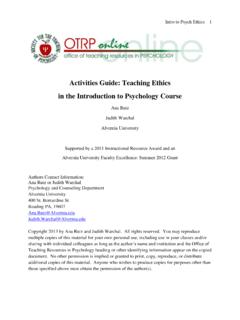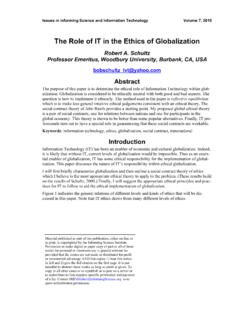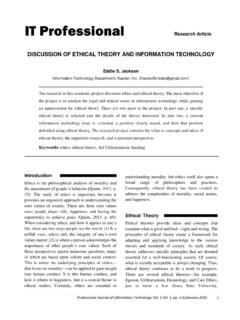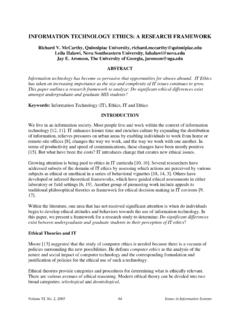Transcription of Ethics Conflicts in Rural Communities: Health …
1 C h a p t e r 14 Ethics Conflicts in Rural Communities: Health information technology David A. FlemingDisclaimerDartmouth Medical School s Department of Community and Family Medicine, the editor, and the authors of the Handbook for Rural Health Care Ethics are pleased to grant use of these materials without charge providing that appropriate acknowledgement is given. Any alterations to the documents for local suitability are acceptable. All users are limited to one s own use and not for effort has been made in preparing the Handbook to provide accurate and up-to-date information that is in accord with accepted standards and practice. Nevertheless, the editor and authors can make no warranties that the information contained herein is totally free from error, not least because clinical standards are constantly changing through research and regulation. The authors and editor therefore disclaim all liability for direct or consequential damages resulting from the use of material contained in this book.
2 Although many of the case studies contained in the Handbook are drawn from actual events, every effort has been made to disguise the identities and the organizations Handbook for Rural Health Care Ethics provides general Ethics information and guidance. Due to complexities and constant changes in the law, exceptions to general principles of law, and variations of state laws, Health care professionals should seek specific legal counsel and advice before acting on any legal-related, Health care Ethics , we have sought to ensure that the URLs for external Web sites referred to in the Handbook are correct and active at the time of placing this material on the home Web site. However, the editor has no responsibility for the Web sites and can make no guarantee that a site will remain live or that the content is or will remain for Rural Health care Ethics : a Practical Guide for ProfessionalsDartmouth College PressPublished by University Press of New EnglandOne Court Street, Suite 250, Lebanon NH 2009 Trustees of Dartmouth College, Hanover, NHEdited by William A.
3 NelsonCover and text design by Three Monkeys Design Works Supported by NIH National Library of Medicine Grant # 5G13LM009017-02 CHAPTER 14 Ethics Conflicts in Rural Communities: Health information TechnologyDavid A. FlemingABSTRACTThe use of Health information technology (HIT) is becoming increasingly important in medical providers efforts to support decision-making and to promote quality Health care delivery and equitable access to services in Rural areas. However, technological interventions in remote settings have attracted Ethics concern and conflict. Complex patient information processes, service shortages, high demand, and a widening array of medical interventions and treatments constantly challenge Health care providers as they struggle to maintain standards of care. For patients in Rural areas, barriers to reasonable access for even basic Health care services, such as primary care, screenings, and prevention, are also common.
4 Numerous technologies have been introduced in recent years to remote sites, with the intention of enhancing quality and improving access. However, as with any well-meaning and innovative medical advance, these technologies bring both intended and unintended consequences to the lives and welfare of patients. This chapter will address four domains of Health information technology : telehealth, electronic medical records, electronic clinical support, and online prescribing services. These technologies bear careful scrutiny when deployed in Rural settings, due to both the nature of the setting and the complexity of the technology . When deploying HIT in any setting, Rural or urban, Health care providers must place patient welfare above all other considerations, protect confidentiality, ensure privacy, promote trust in the healing relationship, and ensure fair and equitable access to quality Common Ethics Issues in Rural CommunitiesCASE STUDIES case | Privacy and consent issues when using telehealth in Rural areasGina Conti is 75 years old, with multiple chronic medical conditions including severe rheumatoid arthritis.
5 She lives in a Rural chronic-care nursing facility, and requires a wheelchair to get around. Mrs. Conti was recently seen by her family physician for a persistent rash. Following several failed diagnoses and treatments, her physician recommended referral to a dermatologist at a university hospital 60 miles away. Neither Mrs. Conti nor her physician feels that she can make a trip of this kind due to her fragile condition, but since the local hospital is part of the university s telehealth network, Mrs. Conti agrees to have the dermatology consultation done remotely. Mrs. Conti is not sure what to expect, and has only been informed that she will, .. be seeing a skin doctor on the TV screen. Upon arrival at the local hospital, Mrs. Conti is taken to a room near the emergency room waiting area where the dermatologist appears on a videoconferencing screen. Mrs. Conti feels a little uneasy while talking to the dermatologist on the screen, especially when the dermatologist asks the nurse to disrobe Mrs.
6 Conti so her rash can be examined. The nurse is instructed to use a special camera for a closer examination of the rash on Mrs. Conti s buttocks, and scrapings are taken and sent to the lab. Mrs. Conti notices that the dermatologist seems to be talking to someone else, but it isn t until the session is almost over that she realizes that a student and resident have been present off-camera, without her knowledge or permission having been requested. When Mrs. Conti is wheeled out of the telehealth room, she feels as though people in the ER waiting room are staring. She is grateful to have seen a skin specialist without having to travel far, but wonders why her physician didn t give her more advance warning about what to expect in the video consultation. Health information technology 279case | Availability of, and access to, electronic medical records (EMR)Dr. Adams, a Rural general internist, is on call for his three-person group.
7 He is in the ER seeing a patient who normally sees one of Dr. Adams partners. Lars Danielson is a 57-year-old male, who was referred to an out-of-town cardiologist last week for evaluation of recurrent chest pain. Mr. Danielson is concerned because he is still having chest pain, and wants to know more about the previous tests, and why he is on so many new medications. He feels dizzy and nauseated and thinks it might be due to one of the new drugs, so he has stopped taking them all. Dr. Adams has Mr. Danielson s medical record, and there is no information from the cardiologist, other than a brief discharge summary stating, inoperable coro-nary artery disease, and a list of several new medicines. The letter indicates that the patient s electronic medical record (EMR) provides a full account of his hospital stay. Dr. Adams group uses a paper record system, and the clinic has only one computer, used only for billing and appointments.
8 Although it would be useful, Dr. Adams group can t afford an EMR system. If they had the system, how-ever, he still wouldn t be able to access the patient s hospital record because his clinic is not in the same networked Health care system as the cardiologist s hospital. Dr. Adams will have to call the referral hospital to get a faxed copy of the patient s record. Meanwhile, Mr. Danielson is complaining of chest pain and becomes short of | Using electronic clinical decision support systemsRobert Taft is a 65-year-old general contractor in a small Rural community. He has been unusually tired for several days, and while at a construction site, he becomes very nauseated and fatigued. When symptoms persist for 20 minutes, he agrees to be driven to the emergency department of his 20-bed community hospital. When the physician, Dr. Kimberly Russell, arrives 15 minutes later, Mr. Taft feels much better except for mild fatigue.
9 Dr. Russell examines Mr. Taft and finds no abnormalities other than mild blood pressure elevation and a slightly rapid pulse. Lab work is normal, and an ECG is electronically interpreted as having nonspecific ST 280 Common Ethics Issues in Rural Communitiesabnormalities. Still concerned, Dr. Russell performs a second ECG using new software that electronically interprets and predicts the probability of cardiac ischemia. The second ECG report estimates an 80% probability of cardiac ischemia. With this information , Mr. Taft agrees to be transferred to a university hospital. There, a cardiac catheterization finds a 95% blockage in one of his coronary arteries, which is then dilated and stented. No cardiac damage is found, and Mr. Taft returns to work the following week. case | Addressing patient use of online treatment and prescribing servicesGwen Thompson lives alone in a remote Rural area. She frequently goes online to get information , and to obtain goods and services that are not easily accessible due to her isolation.
10 She has recently been diagnosed with hypertension, but finds it difficult to keep appointments at the clinic 20 miles away. Ms. Thompson ran out of one blood pressure medicine several weeks ago and has been feeling light-headed. She also noticed that her blood pressure has been running high. It is winter, the roads are bad, and she fears going out, so she begins taking double the prescribed daily dose of the other blood pressure medication that she has not run out of. While surfing the net, she finds and discovers that a virtual house call can be obtained for a modest fee, so she requests a house That same day a physician (in a different state) responds online and Ms. Thompson describes her symp-toms, gives her recent blood pressure readings, and mentions that she has run out of medication. The physician offers to provide a one-month prescription, and even arranges for quick mail delivery of the medication. One week later, Ms.











